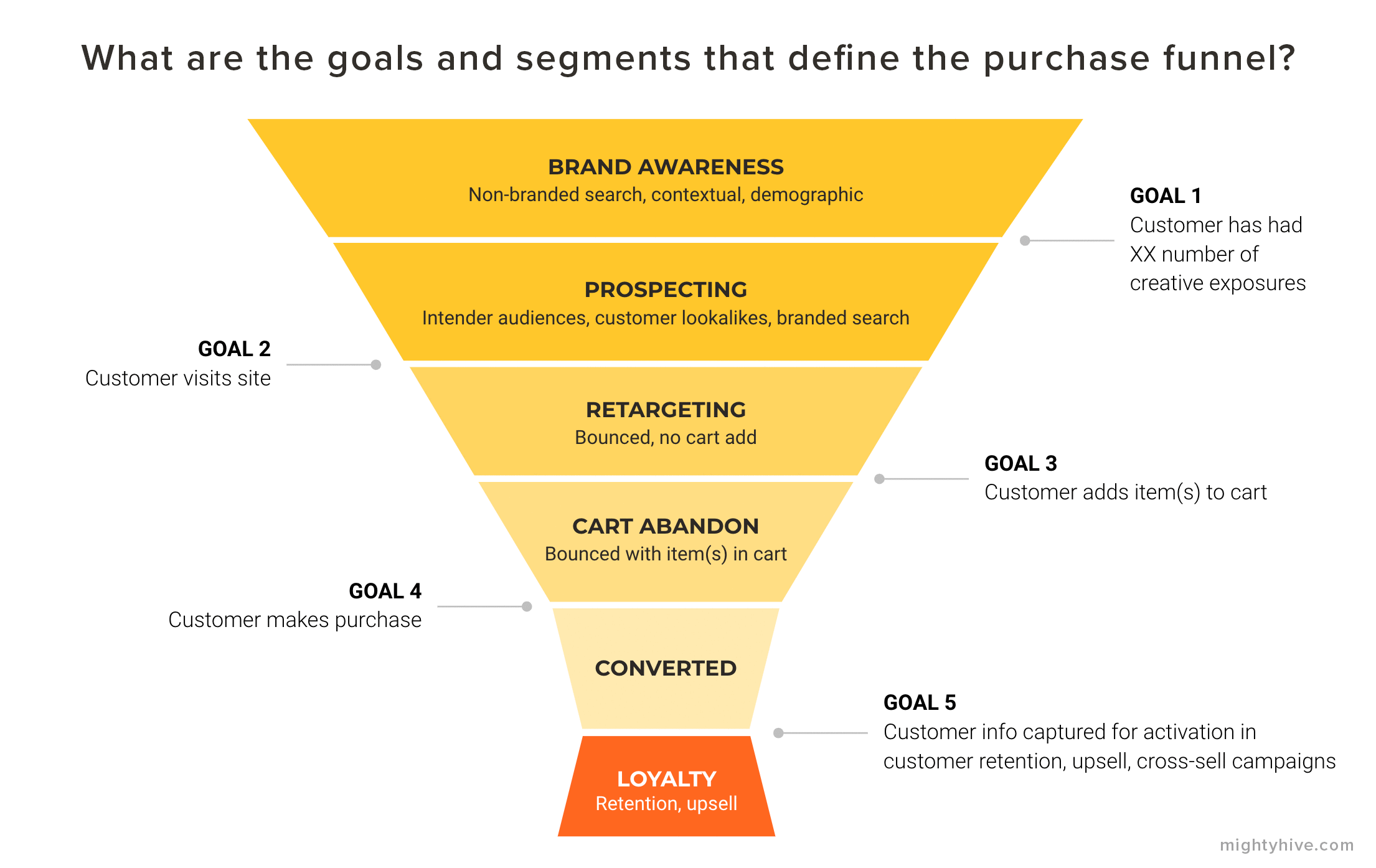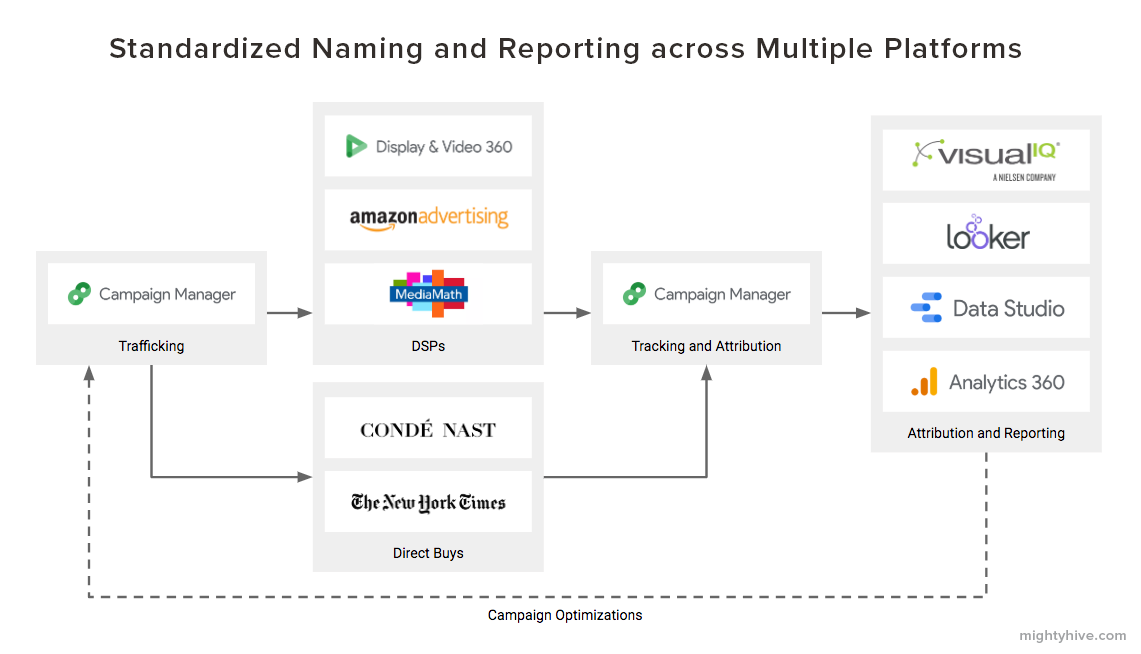
A digital marketer's world is filled with fire drills, deadlines, and distractions. Between budgets, launch dates, and optimizations, campaign naming conventions might be pretty low on your list of priorities. But investing time up front to build a consistent campaign naming convention will pay off over the long run and allow you to:
- Understand campaign goals and details at a glance using just the campaign name
- Resolve insights across campaigns, channels, creative formats, and funnel stages
- Easily pull together reporting data that spans multiple ad servers and DSPs
- Immediately bring insights and optimizations back to related campaigns, line items, placements, and creatives
Developing a formal campaign naming convention is similar to laying a foundation for a tower. Without a solid foundation, you'll end up with a short tower that doesn't let you see very far. With a strong foundation, you'll be able to build a taller tower, and then keep on adding to it, allowing you see more and see farther than your peers who didn't plan as well.
This post will walk you through the process of developing a campaign naming convention and taxonomy that can be applied to campaigns in your ad server(s), DSP(s), and reporting & attribution platforms.
Developing a formal campaign naming convention is similar to laying a foundation for a tower. Without a solid foundation, you’ll end up with a short tower that doesn’t let you see very far.
Understand your Key Reporting Metrics
Key reporting metrics are perhaps the most important consideration before, during, and at the conclusion of your media campaigns. What needs to be reported on across teams, products, and services? How will campaign results need to be broken down? What are the metrics that will help gauge effectiveness and optimize for the future?
There are a number of important potential reporting variables to think about:
- Products
- Categories/Sub Categories
- Brands
- Targeting/Audience
- Funnel Stage
- Geography (e.g., ZIP, DMA, state)
- Objective
- Publisher
- Quarter/Month/Year
Think about the variables you (and your clients) will want to report on before you start crafting your naming convention; you’ll want to account for all major variables so that you can report on them in a consistent manner once your campaigns start running, regardless of the reporting platform.
What is the Campaign Goal? How Will Customers Convert?
Take the time to research and ask questions to help you gain a deep understanding of your (or your advertiser's) marketing funnel. More importantly, make sure you are very clear on the goals for each campaign. This will inform your campaign structure and naming conventions, which will help you build clean, actionable reporting.
Visualize the funnel. How are you trying to guide consumers through the purchase funnel? When in doubt, draw it out!

Format and Consistency
The care you put into developing campaign naming conventions and taxonomies won't be of much use unless your naming convention format is used with 100% consistency.
1. Pick a Standard Delimiter
Pick a standard delimiter (e.g., underscore, dash, or pipe) to mark where one variable ends and the next begins. This is a must. Do not just use a blank space. A standard delimiter will make reporting and data filterable, regex-friendly, and therefore machine-readable.
Here are some examples of what delimiters look like in practice:
- Underscore-delimited: these_are_my_variables
- Dash-delimited: these-are-my-variables
- Pipe-delimited: these|are|my|variables
Lastly, make sure to note blank spaces with a character different from your delimiter (but don't ever use actual blank spaces!). For example, a pipe-delimited campaign name for a pet supplies advertiser might use underscores to represent blank spaces like this: cats|cat_food|awareness|paid_social|q4_2018.
BEST PRACTICE: USE ALL LOWER CASE
Because many analytics platforms and databases are case-sensitive, your campaign names should be all lower case. This avoids the inconsistencies that tend to emerge when using terms like "site-retargeting," which might also get typed as "Site-retargeting" or "Site-Retargeting." Any inconsistency in capitalization might cause some platforms to interpret multiple different values when in fact there is only supposed to be one value.
However, note that going 100% lower case means that your campaign names can't use any terms or acronyms that rely on capital letters for their meaning.
2. Use a Data Dictionary
Use values consistently. Put together a 'data dictionary' before you start building out naming structures. This will ensure everyone is naming variables in a consistent way (e.g., pick 'PaidSocial' or 'Paid-Social'; everyone should use the same convention). Abbreviations or acronyms should also be agreed upon by all participating parties.
| DATA DICTIONARY STANDARD VALUE | INCORRECT, NON-STANDARD VALUES |
| 300x250 | 300 x 250, medium-rectangle |
| north-america | north america, na, NorthAm |
| run-of-site | ros, RunOfSite, run of site |
| q4_2018 | q4, 2018q4, 4Q_2018 |
3. Arrange your Variables Hierarchically
Arrange variables hierarchically, from broadest to most narrow variables or dimensions. This will be unique to each advertiser. For example, if you find that the brand is the most all-encompassing variable, and product, date, or promotion are more specific, the broad variable should come first. The human brain breaks down problems from big to small, left to right. This structure allows anyone to easily understand your campaign goal just by looking at the name.
Here's a simplified example of what it looks like to have variables descend from broadest on the left to narrowest on the right:

Once you've settled on a hierarchy, it needs to stay locked in. Variables should always be in same order within campaign or placement names. Changes in the order of variables will break reporting.
When you put everything together, here's a more realistic example of how a campaign naming convention for a pet food advertiser might look like:

Clean Data In, Clean Data Out
Once you have a plan in place, you're ready to start naming your campaigns! By being consistent with your setup, you can easily interpret campaign goals at a glance, and anyone should be able to make ad-hoc analyses simply by filtering for variables like creative size, funnel stage, campaign objective, etc.
This approach easily solves issues caused by reporting across multiple DSPs and platforms. The example below shows a complex setup, and in this instance all teams associated with this account can report across all DSPs and platforms seamlessly, delivering comprehensive and actionable reporting and attribution.

Apples to Apples FTW!
Intelligent, strictly-applied naming conventions will let you report on, generate insights for, and optimize your campaigns quickly and easily, even across multiple DSPs and reporting platforms. Consistency lets you instantly filter and pivot across variables.
With clean, apples to apples data, you can quickly identify both weak and strong points within your campaigns (e.g., pause a certain creative size because it's performing poorly across multiple campaigns and placements, or put more budget towards a certain geo because it is generating a lot of conversions), leading to faster optimization and stronger performance.
